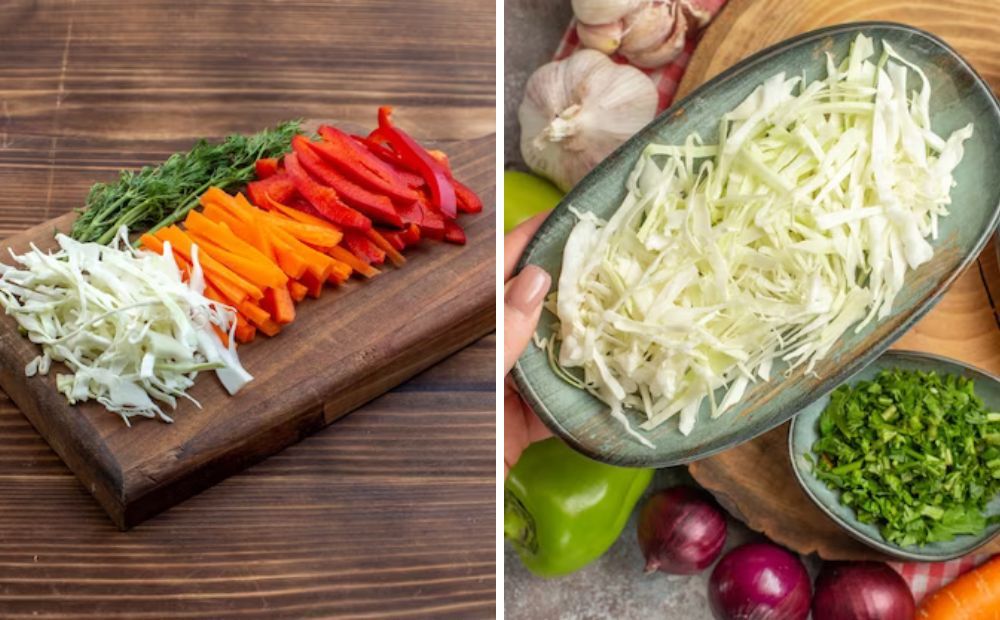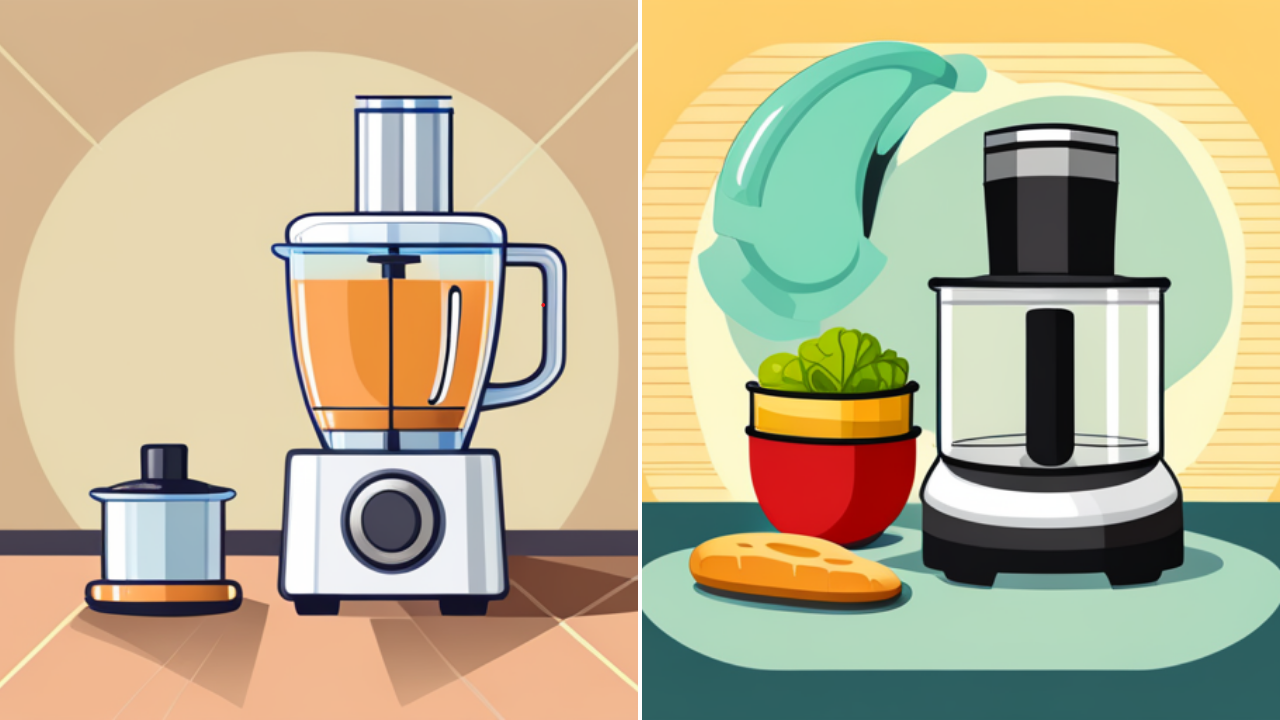In today's fast-paced world, the kitchen has seen a revolution in tools and gadgets designed to make cooking more efficient and enjoyable. One such indispensable tool is the food processor.
This versatile appliance has transformed the way we approach food preparation, offering a combination of speed, precision, and convenience.
The food processor is not just about blending or pureeing; it's a multi-functional tool that does much more than just chop veggies.
One of its most celebrated uses is for chopping and slicing vegetables together. Imagine the time saved from manually dicing onions or shredding cabbage.
With a food processor, these tasks become a breeze, ensuring consistent cuts and saving precious time.
Moreover, the benefits of using a food processor extend beyond just convenience. It ensures uniformity in size, which can be crucial for cooking as it ensures even cooking.
Plus, with the various blade attachments available, you can slice, dice and shred vegetables, and even julienne, making it an all-in-one solution for your vegetable preparation needs.
Choosing the Right Vegetables
Selecting the right produce is the first step to achieving perfect results with your food processor. It's imperative to choose fresh, raw vegetables.
Fresh produce not only ensures better taste and nutrition but also processes better, giving you the desired texture and consistency.
There are a plethora of vegetables that can be efficiently processed. However, some are more suited than others.
Vegetables like carrots, cucumbers, bell peppers, and zucchinis are ideal due to their firm texture.
On the other hand, baking vegetables like potatoes and yams can also be processed, but it's essential to ensure they are firm and not overripe.
Leafy greens like spinach and kale can be chopped, but it's best to use the pulse function to avoid over-processing.
Understanding the types of vegetables and their characteristics can help you make the most of your food processor.
Prepping Your Vegetables
Washing
Before any chopping begins, it's essential to ensure your vegetables are clean. Using a large bowl filled with water is an effective method.
Simply submerge your vegetables, swish them around gently to dislodge any dirt or debris, and then rinse under running water.
This step ensures your veggies are free from contaminants and ready for processing.

Washing vegetables
Peeling
While some vegetables are best used with their skin on, others like carrots, potatoes, and cucumbers might require peeling.
A vegetable peeler is your best friend here. It's designed to remove the thin outer layer without wasting the nutritious part of the vegetable.
Hold the vegetable firmly and run the peeler from its top to bottom, ensuring all the skin is removed.
Remember, the skin of many vegetables holds a significant amount of nutrients, so consider your recipe and personal preference before deciding to peel.
Trimming
Once your vegetables are washed and possibly peeled, the next step is trimming.
Using a sharp paring knife, chop off the ends of vegetables like broccoli stalks, onion tops and bottoms, and the tips of carrots and celery.
For garlic, you'd want to remove the hard root end. This not only gets rid of the inedible parts but also makes the subsequent chopping and slicing process smoother.
For vegetables like broccoli, you can even save the stalks for soups or stir-fries, ensuring no part goes to waste.
Removing Unwanted Parts
Inspect your vegetables for any blemishes, bruises, or imperfections. Using a knife, carefully cut away any unwanted parts or areas that seem rotten.
This step ensures that only the best parts of the vegetable make it to the final dish, enhancing both the taste and appearance of your culinary creation.
Sizing
Before tossing your vegetables into the food processor, it's crucial to cut them down to a manageable size.
Using a cutting board, chop your vegetables and herbs into smaller pieces that can easily fit into the processor. This not only ensures even chopping but also prevents overloading the machine.
For instance, a large carrot can be halved or quartered, while a bell pepper can be sliced into strips.

Sliced Vegetables
Tips
For optimal processing in a food processor, it's recommended to cut vegetables into 1 to 2 inches long pieces.
This size is ideal as it allows the blades to efficiently chop the veggies without turning them into a mushy mess.
Additionally, uniform-sized pieces ensure even cooking, especially crucial for dishes where consistency matters.
Another tip is to always ensure your vegetables are dry after washing. Excess water can affect the chopping process and the final texture of the dish. Lastly, always remember to not overfill the food processor.
Overloading can result in uneven chopping and might even strain the appliance. It's always better to process in batches for the best results.
Chopping the Vegetables
Loading the Processor
The first step to efficient chopping with most food processors is loading the food processor correctly. Begin by ensuring the blade attachment is securely in place.
Then, introduce the prepped vegetable pieces into the processor's bowl through the feed tube. It's essential not to overload the machine; instead, fill it to about two-thirds or as per the manufacturer's recommendation.
This ensures that the blades have enough space to move freely, resulting in even chopping.
How-To Use a Food Processor to Chop Up Vegetables | Chef Sasha Sincic - The Desire Company
Settings
Every food processor comes with a variety of settings. These settings determine the fineness of the chop.
For a coarse chop, you might use a pulsing action, giving you more control over the size. For a finer chop or almost pureed consistency, you'd let the food processor blades run continuously.
It's crucial to familiarize yourself with your machine's settings. The manual can be a helpful guide, providing insights on which setting is best for different vegetables and desired outcomes.
Remember, the goal is to achieve uniformity in size for even cooking and presentation.
Monitoring
While many food processors now are designed to make our lives easier, it's essential to monitor the chopping process.
Keep an eye on the consistency and stop the machine intermittently to check the size of the vegetable pieces. This ensures that you don't end up with a mixture that's too fine or uneven.
If you're using the pulse function, short, quick pulses allow for more control and prevent over-processing.
The transparent bowl of most processors is beneficial in this regard, letting you observe the progress without stopping the machine.
Dicing veggies in a food processor
Re-chopping
Sometimes, after the initial round of chopping, you might find some pieces that aren't chopped to your satisfaction.
This is where re-chopping comes into play. Remove the finely chopped pieces and set them aside.
Then, run the machine again to process the larger chunks. It's a step that ensures consistency in your vegetable pieces, especially vital for dishes where texture plays a significant role.
Tips
If you often find yourself short on time, consider chopping large quantities of vegetables in one go.
Once chopped, portion them out into meal-sized batches and freeze. This way, you have pre-chopped veggies ready for quick meals.
Ensure you store them in airtight containers or freezer bags to retain freshness.
This method not only saves time on busy days but also reduces the wear and tear on your food processor from frequent use.
Finishing and Cleaning Up
Removing Vegetables
Once you are finished chopping vegetables to perfection, the next step is removal. Using a rubber spatula, scrape down the sides of the processor bowl to ensure no bits are left behind.
The spatula's flexibility allows it to conform to the bowl's shape, ensuring maximum retrieval. For any stubborn pieces or for scooping out the chopped vegetables, a spoon can be handy.
It's essential to be gentle during this process to ensure the blade and the bowl aren't scratched or damaged.
Cleaning
Maintaining your food processor's cleanliness ensures its longevity and performance. Start by disassembling the machine, removing the blade, lid, and bowl.
Using warm, soapy water, wash each part thoroughly. A soft brush can be beneficial for cleaning the blade and any nooks or crannies. Ensure that the blade is handled with care to prevent any accidental cuts.
Once cleaned, rinse each part under running water to remove any soap residue. Allow the parts to air dry completely before reassembling to prevent any bacterial growth.
If your food processor parts are dishwasher safe, you can place them in the dishwasher for a thorough clean. However, always refer to the manufacturer's instructions.
Safety Precautions
Safety should always be a priority when using and cleaning kitchen appliances. Here are some crucial safety precautions:
- Children: Ensure that children are kept away from the food processor, especially when it's in operation. The sharp blades can be hazardous.
- Wet Hands: Never touch the food processor, especially near the plug or electrical cord, with wet hands. This can lead to electric shocks.
- Sharp Parts: Always handle the blades and other sharp parts with care. When cleaning, it's advisable to wear gloves or use a brush to prevent accidental cuts. Store the blades in a safe place, out of reach of children.
By adhering to these safety guidelines, you can ensure a safe and efficient experience with your food processor.
Summary
In the realm of kitchen appliances, the food processor stands out as a beacon of efficiency and versatility.
From selecting the freshest vegetables to mastering the art of chopping and ensuring safety, every step is crucial in achieving culinary excellence.
As we've explored, the food processor simplifies these steps, turning tedious tasks into effortless endeavors.
By understanding its capabilities and following the guidelines outlined, you can harness the full potential of this remarkable tool.
So, the next time you're faced with a mountain of vegetables to chop, let your food processor be your trusted ally, ensuring consistency, saving time, and elevating your dishes to new heights.

FAQs
How long should vegetables be processed in a food processor?
The processing time varies depending on the vegetable and the desired consistency. Typically, for a coarse chop, a few short pulses should suffice. For a finer texture, you might need to run the processor continuously for 20-30 seconds. Always monitor to avoid over-processing.
Can all vegetables be chopped in a food processor?
Most vegetables can be processed, but the outcome varies. Firm vegetables like carrots and bell peppers chop well, while softer ones like tomatoes might become pureed.
What are the safety precautions to take when using a food processor?
Always ensure the machine is off before assembling or disassembling, keep away from children, and handle blades with care.
Can you use a food processor for grating parmesan cheese?
When it comes to grating Parmesan cheese, a food processor can be especially handy, particularly if you have a large block of cheese or need a significant amount grated. Pro tip: use the S shaped blade and not the grater given how hard parmesan cheese its.
What size food processor to get to chop vegetables?
Choosing the right size food processor for chopping vegetables depends on several factors, including the quantity of vegetables you typically process, the size of your kitchen, and your storage capabilities.
When do you use the slicing disk attachment in a food processor?
The slicing disk attachment in a food processor is used when you want to cut vegetables, fruits, or cheeses into uniform, thin slices.










